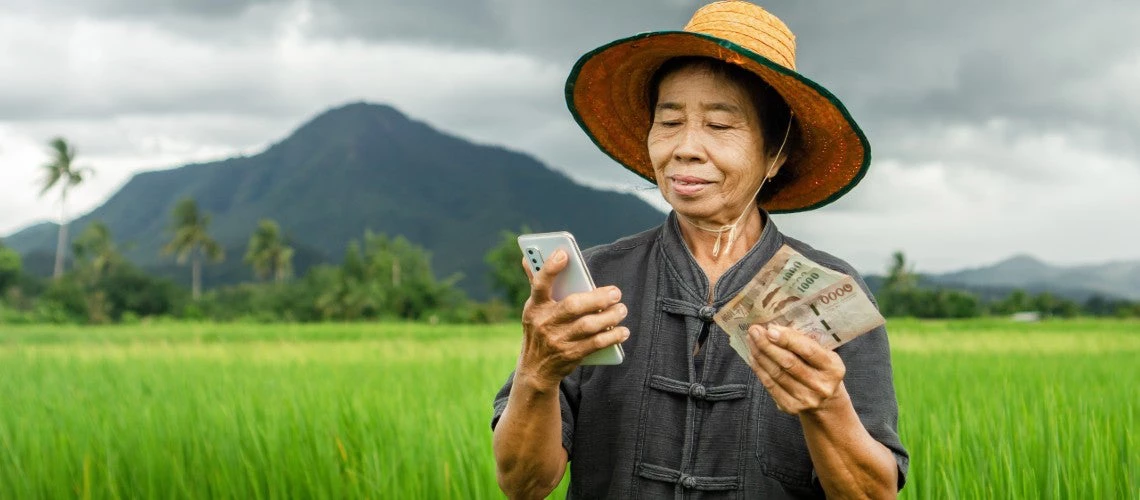 Smiling Asian woman farmer holds Thai banknotes and a mobile phone, illustrating the benefits of cash subsidy
Smiling Asian woman farmer holds Thai banknotes and a mobile phone, illustrating the benefits of cash subsidy
After a brief period of decline, energy subsidies have been rising over the last two years, as global economic recovery drove up oil demand, and along with it prices for oil and key commodities. The food and fuel price shocks of 2022 led governments around the world to introduce measures to shield their citizens, economies, and businesses from the harshest impacts of the crisis. In fact, according to an ongoing global tracking effort by the World Bank, between July 2021 and April 2023, at least 65 countries introduced or expanded fuel subsidies, and at least 143 countries announced a total of 439 energy-related measures, including subsidies for fuel, electricity, and transport. By the end of 2022, total global support for the consumption of fossil fuels exceeded US$1 trillion, according to estimates from the International Energy Agency.
Despite their substantial fiscal cost, multiple negative impacts, and unintended distributional outcomes, energy subsidies remain an integral part of the policy toolbox. Policymakers can be wary of pursuing ambitious energy subsidy reforms despite their necessity and benefits in the long term, due to their perceived risks and potential political costs. A central question here is how potential price increases would impact the citizens, particularly the poor and vulnerable. These are all legitimate concerns.
Fortunately, highly effective tools to address these concerns are available. Cash transfers can help governments manage potential distributional and welfare impacts of energy price increases. In fact, over the past two decades, several governments successfully deployed these tools as part of energy subsidy reforms.
In our recent report, Cash Transfers in the Context of Energy Subsidy Reform: Insights from Recent Experience, we reviewed recent approaches to using cash transfers to mitigate the effects of energy subsidy reforms on affected households. Our report takes stock of two decades of country experiences with reform-related cash transfers, exploring diverse approaches to program design, beneficiary selection, enrollment, benefit delivery mechanisms, and scale-up and down.
This stocktaking examined 24 energy subsidy reform episodes that took place from the mid-1990s on, where governments used social assistance measures. New cash transfer programs were introduced in two-thirds of the cases, while existing programs were leveraged in one-third.
The review shows that coverage of cash transfer programs varied significantly across countries, with some countries providing rather broad-based support, reaching more than 70 percent of their population, while in others, coverage was much lower, sometimes below five percent. The cash transfer programs also varied in their identification approach, with some using existing social registries, while others involved leveraging national identification system, or requiring beneficiaries to apply.
Our report includes two case studies on how different countries used cash transfers to successfully mitigate the impacts of energy subsidy reforms. In the Dominican Republic, under the national “Bonogas” program, in existence for over a decade, the government created two separate compensatory cash transfer schemes for households and transport operators, thereby addressing the needs of two key constituencies affected by fuel subsidy reforms. The careful beneficiary selection and relatively high coverage of the program helped ensure that the transfers targeted not only the poor but also the vulnerable and the middle class, therefore being inclusive by design. On the other hand, in Ukraine, while faced with fiscal crisis and external pressures, the government introduced ambitious reforms between 2014 and 2016 and effectively leveraged an existing social assistance program, the Housing and Utilities Subsidy (HUS), to rapidly deliver support to its citizens. The program had strong results, and the government continued to refine its design and strengthen the broader social assistance system in parallel, over the years.
There are tradeoffs that decision-makers need to consider while using cash transfers to support energy subsidy reforms. For example, our review shows that the scope of cash transfers—their generosity (amount) and coverage (share of population they reach)—directly influences the extent of fiscal savings from reform. Encouragingly, the review indicates that even when governments introduced cash transfers, many reforms still generated net fiscal savings. It is also worth highlighting that fiscal savings are but one of the many benefits of energy subsidy reform.
Our review shows that with good design and implementation, cash transfers can mitigate potential negative distributional impacts of energy subsidy reforms, helping build trust, and support for reform. An overarching conclusion is that mitigation measures should be an integral part of the reforms from the start. Moreover, compensating households for energy price increases alone is not enough, and should be accompanied by the creation, expansion, and strengthening of a social protection system that supports the resilience of households over the medium and the long run. Going forward, equitable, efficient, and adaptive social protection systems will have a central role in supporting energy sector reform and transition more broadly.
Subscribe here to stay up to date with the latest Energy blogs.






Join the Conversation